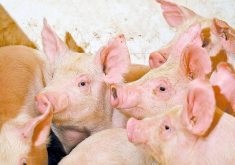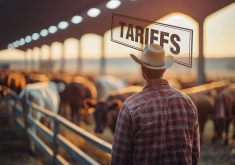Mark McNaughton raises 50 tonnes of tilapia a year for Asian markets and restaurants in Calgary and Edmonton
Alberta and fishery aren’t words commonly used together, but Mark McNaughton grows nearly 50 tonnes of fish a year.
Along with his 3,500 acres of wheat, canola and barley, the Trochu producer has anywhere from 50,000 to 60,000 tilapia in his a “big giant aquarium” housed on his farm. Just like the home version, you need to monitor and manage levels of oxygen, carbon dioxide, ammonia and fecal matter.
“Those are the four steps you need to take care of, just like a little water treatment plant,” said McNaughton. “You can have all the fish that you want, but if you don’t have a system to take care of that water quality, it won’t do you any good.”
Read Also

Horns aren’t unlocking anytime soon on livestock transport standards
Standards good enough meet the definition of “humane” animal transportation still vary widely between what what industry wants, what animal rights advocates want and, between the two, what federal regulators decide is good enough.
MDM Aqua Farms began by raising trout in 1999, when a downturn in the hog market prompted him to get out of that business. The fish were used to stock trout ponds, but that created a serious logistical problem.
“We were trying to seed and deliver fish all across southern Alberta in May and that didn’t work out too well,” he said. “We got to know some guys who were raising tilapia and couldn’t keep up so they started importing live tilapia from the U.S. for the Asian markets.”
McNaughton, whose outfit is one of four tilapia farms in Alberta, takes in three batches of 30,000 fingerlings three times a year. He ships — in totes in a cube van — about 1,000 fish weekly to a wholesaler who delivers the fish to restaurants and Asian markets in Edmonton and Calgary. At that point, they weigh nearly one and one-half pounds and will be kept live in tanks until selected by customers.
Native to the Nile river, tilapia is a white-meat freshwater fish that reaches maturity in a few months. They’re also sturdy critters who can handle the stress of repeated transport.
“They can take a lot more abuse than a salmon and a trout such as lower oxygen levels and higher ammonia levels in the water,” said McNaughton. “But they’re not invincible.”
Neither are Alberta tilapia producers, who are well aware their tiny market could easily be swamped by much larger American ones.
“They can grow fish a lot cheaper in the U.S. than we do, because they can grow fish outside,” he said. “If they get a bit of overproduction in the U.S., they start to look for markets somewhere else.”
Raising fish is fairly similar to pigs in many ways, but there are key differences, he said.
“The pigs were a lot simpler because there is a lot less going on,” he said. “In fish, you’re basically building the environment. If something goes wrong and the water stops moving, they’re dead.”
To avoid that dire situation, McNaughton employs back-up pumps, oxygen, alarm systems and generators. His fish live in two barns with a number of smaller tanks filled with well water and filtration systems. Energy costs are the biggest expense for the operation.
The fish eat a mixture of wheat and soybean pre-made pellets, and McNaughton only raise males because they grow faster. He also wants to avoid breeding, as baby fish can get caught in filters and other parts of the aquarium. His operation is small-scale and would never be viable if he wasn’t farming about 3,500 acres of wheat, barley and canola, he said.
There has been a growing interest in aquaponics (raising fish and produce in a partially closed loop system), but McNaughton said he hasn’t seen a large commercial growth in the industry in Alberta. He’s got a small aquaponics and greenhouse system on his farm, but said he considers it a hobby.















